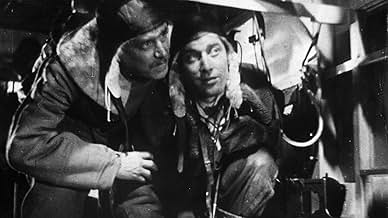अपनी भाषा में प्लॉट जोड़ें1937, during the spanish civil war, at Teruel. The fight of the Republicans (with very poor means but high commitment) against fascist army of General Franco. Can be seen as romanticized wit... सभी पढ़ें1937, during the spanish civil war, at Teruel. The fight of the Republicans (with very poor means but high commitment) against fascist army of General Franco. Can be seen as romanticized witness of director and writer Andre Malraux, who joined the Republicans in 1936.1937, during the spanish civil war, at Teruel. The fight of the Republicans (with very poor means but high commitment) against fascist army of General Franco. Can be seen as romanticized witness of director and writer Andre Malraux, who joined the Republicans in 1936.
- पुरस्कार
- कुल 1 जीत
कहानी
क्या आपको पता है
- ट्रिवियाRe-titled 'Man's Hope', this film's earliest documented telecast took place in Cincinnati Sunday 2 October 1949 on WKRC (Channel 11).
- कनेक्शनEdited into Histoire(s) du cinéma: Une vague nouvelle (1999)
- साउंडट्रैकFuneral march
Composed by Darius Milhaud
This is a fiction/documentary film written/directed by Andre Malraux based on a chapter of his novel ¨La Esperanza¨ or ¨The hope¨ . It includes spectacular scenes of street fighting and a bombing raid , adding shot footage . And an impressive as well as epic finale with lots of people helping the injured pilots transported through mountains , influenced by classy Russian filmmakers (Sergei M Eisenstein , Pudovkin) and in Italian Neorrealist style . Film copies were pursued by the Gestapo , though remained one washed-out print , subsequently being remastered and it was not commercially released until 1945 . Malraux wrote the novel L'Espoir, or Man's Hope, being supervised and assisted by the prestigious Max Aub , published in 1937 , which was basis for the film . The crash of a Spanish Republican Air Force Potez 540 plane near Valdelinares inspired André Malraux to write the novel . Different years are given for the film's completion . The novel was published in French in 1937 and in English in 1938 . The film uses war footage from 1938 and was edited , and other scenes shot, during 1938-1939 . It was finished in July 1939 and shown twice in Paris , but the Francoist regime applied pressure to censor it . All known copies were destroyed during World War II , since both Spain and France were ruled by Fascist regimes sympathetic to the forces that shot down the plane . A copy was found and the film was released again in 1945 . In Spain , it was banned and was not screened until 1977, after the death of dictator Franco .
Spanish/French co-production , being financed by 2º Republic , supported by French government and producer Eduard Cogniglion Molinier . Sierra De Teruel (English title : Days of Hope or Man's Hope) is a 1938-39 Spanish-French black and white war film well photographed by Manuel Berenguer , Louis Page and other cameramen , and compellingly directed by Boris Peskine and André Malraux in his only movie . It can be seen as romanticized witness and a lyrical work of filmmaker and screen-writer Andre Malraux. The novelist and essayist André Malraux (1901-1976) , who joined the Republicans in 1936 , was a commandant of an aviation squadron during Spanish Civil war and resistance member against the invading Nazis in WWII . This notorious writer/director won the 1945 Prix Louis Delluc .
This unfinished ¨Sierra De Teruel¨ is considered to be the best film about Spanish Civil War , along with ¨The Last Train from Madrid¨ (1937) by James P. Hogan ; ¨Blockade¨ (1938) by William Dieterle ; ¨Comrades at Sea¨ (1938) or ¨Kameraden Auf See¨ by Heinz Paul ; ¨Frente De Madrid¨ (1939) by Edgar Neville ; ¨Arise, My Love¨ (1940) by Mitchell Leisen ; ¨The siege of Alcazar¨(1940) by Augusto Genina ; ¨The Squadron¨ (1941) by Antonio Román , ¨Rojo y negro¨(1942) by Carlos Arévalo ; ¨The Fallen Sparrow¨ (1943) by Richard Wallace ; ¨For Whom the Bell Tolls¨ (1943) by Sam Wood ; ¨The Angel Wore Red¨ (1960) by Nunnally Johnson ; ¨La Paz Empieza Nunca¨ (1960) by Leon Klimovsky ; ¨Five Cartridges¨(1960) by Frank Beyer ; ¨Morir En Madrid¨ (1963) by Frederic Rossiff ; ¨Behold a Pale Horse¨ (1964) by Fred Zinnemann ; ¨Viva la Muerte¨ (1971) by Fernando Arrabal , among others .
टॉप पसंद
विवरण
- चलने की अवधि1 घंटा 16 मिनट
- रंग
- पक्ष अनुपात
- 1.37 : 1
इस पेज में योगदान दें










